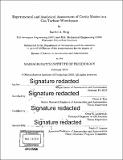| dc.contributor.advisor | Choon S. Tan and Greg M. Laskowski. | en_US |
| dc.contributor.author | Berg, Rachel A. (Rachel Antonette) | en_US |
| dc.contributor.other | Massachusetts Institute of Technology. Department of Aeronautics and Astronautics. | en_US |
| dc.date.accessioned | 2016-07-01T18:41:04Z | |
| dc.date.available | 2016-07-01T18:41:04Z | |
| dc.date.copyright | 2016 | en_US |
| dc.date.issued | 2016 | en_US |
| dc.identifier.uri | http://hdl.handle.net/1721.1/103445 | |
| dc.description | Thesis: S.M., Massachusetts Institute of Technology, Department of Aeronautics and Astronautics, 2016. | en_US |
| dc.description | Cataloged from PDF version of thesis. | en_US |
| dc.description | Includes bibliographical references (pages 103-106). | en_US |
| dc.description.abstract | High response pressure data from a high-speed 1.5-stage turbine Hot Gas Ingestion Rig shows the existence of cavity modes in the rim-seal-wheelspace cavity for representative turbine engine operating conditions with purge flow. The experimental results and observations are complemented by computational assessments of cavity modes associated with flow in canonical cavity configurations. The cavity modes identified include Shallow Cavity modes and Helmholtz resonance. The response of the cavity modes to variation in design and operating parameters are assessed. These parameters include cavity aspect ratio, purge flow ratio, and flow angle defined by the ratio of primary tangential to axial velocity. Scaling the cavity modal response based on computational results and available experimental data in terms of the appropriate reduced frequencies appears to indicate the potential presence of a Deep Cavity mode as well. Computational assessment of canonical cavity flow suggests that increasing purge flow ratio mitigates Shallow Cavity modal response, in accord with data for the first Shallow Cavity mode but in contrast to data for the second Shallow Cavity mode. Likewise, increasing primary flow angle reduces the Shallow Cavity modal response that vanishes for flow angle beyond 450*. This computational observation is in contrast to the rig data that show the modal response is nevertheless present with a flow angle greater than 45*. An implication from the computational parametric assessments is that increasing purge flow and primary flow angle could provide a stabilizing effect on the response. Experimental requirements to quantify the effects of cavity modes on hot gas ingestion are identified along with inadequacies in the current rig set-up with the associated instrumentation system. As such, the role of cavity modes on hot gas ingestion cannot be clarified based on the current set of data. | en_US |
| dc.description.statementofresponsibility | by Rachel A. Berg. | en_US |
| dc.format.extent | 106 pages | en_US |
| dc.language.iso | eng | en_US |
| dc.publisher | Massachusetts Institute of Technology | en_US |
| dc.rights | M.I.T. theses are protected by copyright. They may be viewed from this source for any purpose, but reproduction or distribution in any format is prohibited without written permission. See provided URL for inquiries about permission. | en_US |
| dc.rights.uri | http://dspace.mit.edu/handle/1721.1/7582 | en_US |
| dc.subject | Aeronautics and Astronautics. | en_US |
| dc.title | Experimental and analytical assessment of cavity modes in a gas turbine wheelspace | en_US |
| dc.type | Thesis | en_US |
| dc.description.degree | S.M. | en_US |
| dc.contributor.department | Massachusetts Institute of Technology. Department of Aeronautics and Astronautics | |
| dc.identifier.oclc | 952100104 | en_US |
